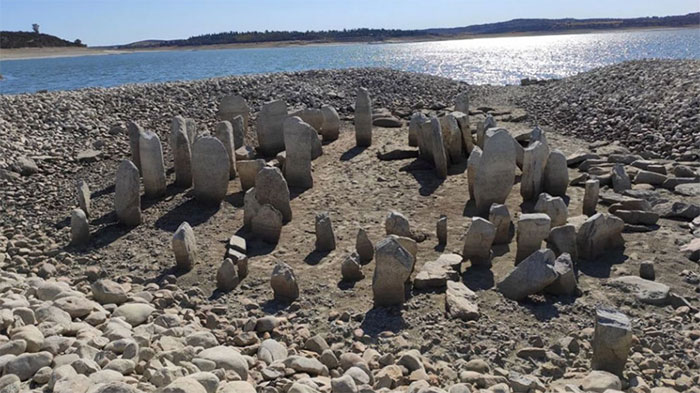The 7,000-year-old Spanish tombstone was first 'exposed' after half a century
After 50 years of hiding from the water of an artificial lake in western Spain, the 7,000-year-old tombstone called the Dolmen of Guadalperal has finally returned to dry land.
As the new image taken from NASA's Landsat 8 satellite shows, the reappearance of ancient ruins is due to the very low water level in Spain's Valdecañas reservoir after a hot and drought-prone summer across the world. Europe.

Thousand-year-old dolmens in Spain.
Sometimes labeled the "Stonehenge of Spain" , the Dolmen of Guadalperal is a large circle of 150 standing stones, more than 1.8 meters high, arranged around a central oval.
Archaeologists speculate that this structure was built in the 4th or 5th millennium BC.
An exceptionally large stone seems to mark the entrance. This stone threshold is engraved with a figure on one side and doodles on the other side may represent a snake or the nearby Tagus river.
If a waterway is actually described, that could make the stone one of the oldest maps in Europe.
Since the creation of the reservoir, the tops of some huge rock blocks have sometimes penetrated the surface of the water, but never before has the entire area been raised at once.
Local research groups have proposed moving the entire site to higher terrain, so that the stones can be studied outdoors and visited by the people. However, some archaeologists are concerned that moving the monument could accelerate its decline, especially if the work is done in such a hurry.
- Sweden discovered an ancient tomb of 5,500 years old
- A pair of mysterious tombs located under "bleeding stones" in China
- 2000-year-old Roman tombstone was found in New York
- Explain the disappearance of the world's second largest fish
- Pandemic & infectious diseases in human history
- Discovered more than 400 years old artillery out of Ireland
- 50 leading electronics in the past half century
- 10 diseases once terrified humans
- German Museum shows off White Snow tombs 'real version'
- 18 doctors exposed to HIV after an effort to gain life for a patient
- Alien prediction will appear right in the 21st century
- A bird perched at the mouth of the opening of the pandemic killed 50 million people
- Brazil: The most severe drought in the past half century
- For the first time, an embryo has been successfully created, half a half pig
 Discovered an ancient centipede fossil 99 million years old
Discovered an ancient centipede fossil 99 million years old Discovered bat-like dinosaurs in China
Discovered bat-like dinosaurs in China Discovered a 200-year-old bronze cannon of the coast
Discovered a 200-year-old bronze cannon of the coast Discover 305 million-year-old spider fossils
Discover 305 million-year-old spider fossils